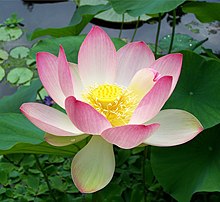


Nelumbo nucifera
Nelumbo nucifera, known by a number of names including Indian lotus, sacred lotus, bean of India, or simply lotus, is one of two species of aquatic plant in the family Nelumbonaceae. The Linnaean binomial Nelumbo nucifera (Gaertn.) is the currently recognized name for this species, which has been classified under the former names, Nelumbium speciosum (Willd.) and Nymphaea nelumbo, among others. Names other than Nelumbo nucifera (Gaertn.) are obsolete synonyms and should not be used in current works. This plant is an aquatic perennial. Under favorable circumstances its seeds may remain viable for many years, with the oldest recorded lotus germination being from that of seeds 1,300 years old recovered from a dry lakebed in northeastern China.
A common misconception is referring to the lotus as a water lily (Nymphaea), an entirely different plant, as can be seen in the center of the flowers, which lack the structure that goes on to form the distinctive circular seed pod in the Nelumbo nucifera.[citation needed]
Native to Tropical Asian nations and Queensland, Australia,it is commonly cultivated in water gardens. It is also the national flower of India and Vietnam.
A common misconception is referring to the lotus as a water lily (Nymphaea), an entirely different plant, as can be seen in the center of the flowers, which lack the structure that goes on to form the distinctive circular seed pod in the Nelumbo nucifera.[citation needed]
Native to Tropical Asian nations and Queensland, Australia,it is commonly cultivated in water gardens. It is also the national flower of India and Vietnam.
(unranked): Angiosperms
(unranked): Eudicots
Order: Proteales
Family: Nelumbonaceae
Genus: Nelumbo
Species: N. nucifera
Botany
The roots of Nelumbo nucifera are planted in the soil of the pond or river bottom, while the leaves float on top of the water surface or are held well above it. The flowers are usually found on thick stems rising several centimeters above the leaves. The plant normally grows up to a height of about 150 cm and a horizontal spread of up to 3 meters, but some unverified reports place the height as high as over 5 meters. The leaves may be as large as 60 cm in diameter, while the showy flowers can be up to 20 cm in diameter.
Researchers report that the lotus has the remarkable ability to regulate the temperature of its flowers to within a narrow range just as humans and other warmblooded animals do. Dr. Roger S. Seymour and Dr. Paul Schultze-Motel, physiologists at the University of Adelaide in Australia, found that lotus flowers blooming in the Adelaide Botanic Gardens maintained a temperature of 30–35 °C (86–95 °F), even when the air temperature dropped to 10 °C (50 °F). They suspect the flowers may be doing this to attract coldblooded insect pollinators. The study, published in the journal Nature, is the latest discovery in the esoteric field of thermoregulation, heat-producing, plants. Two other species known to be able to regulate their temperature include Symplocarpus foetidus and Philodendron selloum.
As mentioned earlier, the traditional Sacred Lotus is only distantly related to Nymphaea caerulea, but possesses similar chemistry. Both Nymphaea caerulea and Nelumbo nucifera contain the alkaloids nuciferine and aporphine.

No comments:
Post a Comment